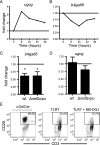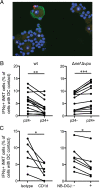Innate Invariant NKT Cell Recognition of HIV-1-Infected Dendritic Cells Is an Early Detection Mechanism Targeted by Viral Immune Evasion
- PMID: 27481843
- PMCID: PMC4991248
- DOI: 10.4049/jimmunol.1600556
Innate Invariant NKT Cell Recognition of HIV-1-Infected Dendritic Cells Is an Early Detection Mechanism Targeted by Viral Immune Evasion
Abstract
Invariant NKT (iNKT) cells are innate-like T cells that respond rapidly with a broad range of effector functions upon recognition of glycolipid Ags presented by CD1d. HIV-1 carries Nef- and Vpu-dependent mechanisms to interfere with CD1d surface expression, indirectly suggesting a role for iNKT cells in control of HIV-1 infection. In this study, we investigated whether iNKT cells can participate in the innate cell-mediated immune response to HIV-1. Infection of dendritic cells (DCs) with Nef- and Vpu-deficient HIV-1 induced upregulation of CD1d in a TLR7-dependent manner. Infection of DCs caused modulation of enzymes in the sphingolipid pathway and enhanced expression of the endogenous glucosylceramide Ag. Importantly, iNKT cells responded specifically to rare DCs productively infected with Nef- and Vpu-defective HIV-1. Transmitted founder viral isolates differed in their CD1d downregulation capacity, suggesting that diverse strains may be differentially successful in inhibiting this pathway. Furthermore, both iNKT cells and DCs expressing CD1d and HIV receptors resided in the female genital mucosa, a site where HIV-1 transmission occurs. Taken together, these findings suggest that innate iNKT cell sensing of HIV-1 infection in DCs is an early immune detection mechanism, which is independent of priming and adaptive recognition of viral Ag, and is actively targeted by Nef- and Vpu-dependent viral immune evasion mechanisms.
Copyright © 2016 by The American Association of Immunologists, Inc.
Figures






References
-
- Mori L., Lepore M., De Libero G. 2016. The immunology of CD1- and MR1-restricted T cells. Annu. Rev. Immunol. 34: 479–510. - PubMed
-
- Brennan P. J., Brigl M., Brenner M. B. 2013. Invariant natural killer T cells: an innate activation scheme linked to diverse effector functions. Nat. Rev. Immunol. 13: 101–117. - PubMed
-
- Kinjo Y., Wu D., Kim G., Xing G. W., Poles M. A., Ho D. D., Tsuji M., Kawahara K., Wong C. H., Kronenberg M. 2005. Recognition of bacterial glycosphingolipids by natural killer T cells. Nature 434: 520–525. - PubMed
Publication types
MeSH terms
Substances
Grants and funding
LinkOut - more resources
Full Text Sources
Other Literature Sources

